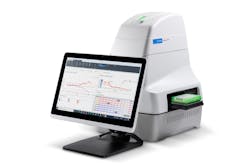Activating immune cell metabolism via solid-state sensors
As sentinels poised to rapidly respond to a host of triggers from foreign antigens to cancer cells, immune cells can modulate their function in a precise and controlled manner. The scientific community has gained a much richer appreciation for the complex and dynamic connections between metabolic poise and immune cell function.
With this understanding comes the ability to monitor and control how metabolic reprogramming, in concert with microenvironmental signals, drives and modulates the function, fate, and fitness of immune cells (see Fig. 1).Metabolic reprogramming
There is an intricate link between dynamic immune cell function or fate and distinct metabolic reprogramming strategies. In their naïve state, T cells primarily use mitochondrial respiration (OXPHOS) to meet adenosine triphosphate (ATP) demands, which are generally lower than they would be in an effector phenotype.
Effector cells, however, require an increase in overall ATP production to achieve the requirements of rapid proliferation. In these cells, glycolysis contributes a relatively larger proportion of total ATP to fuel the accelerated energetic requirements.
Glycolysis is the first responder of energy production—when acute energy demands require a rapid metabolic response, glycolysis can provide that rapid energy. But increasing the glycolytic rate is not sustainable. In contrast, mitochondria are the energetic housekeepers, getting the house back in order after an assault—they’re all about recovery, balance, and longevity.
When immune cells fail to properly regulate their metabolic demands, it can lead to anergy or exhaustion, states that pathogens have learned to exploit. The exploration of the bioenergetics of immune cell fitness, fate, and activation can be achieved with technology such as the Agilent Seahorse XF Analyzer (see Fig. 2), as well as associated assay kits that can be used to measure immune cell metabolic phenotypes in real time.Cell engineering
Engineered immune cells such as chimeric antigen receptor T cell (CAR-T) therapy have shown remarkable efficacy in the clinic against resistant and refractory tumors of hematopoietic origin. But the success of engineered immune cells against solid tumors has been limited for several reasons: lack of tumor-specific antigen targets, homing to and penetration of the tumor by engineered immune cells, the immune-suppressive nature of the tumor microenvironment, and a lack of persistence of the engineered immune cells.
There is an ongoing effort in cell therapy to use genetic engineering approaches to continue to increase the activation, persistence, homing, efficacy, and safety of immune cell therapies. Metabolic poise is likely the most objective determinant of immune cell function and persistence within the tumor microenvironment, and therefore agnostic to strategies that engage various immune pathways and factors. It can objectively establish which approach enhances immune cell function, particularly against more formidable tumors, and advance candidate therapies to animal testing and ultimately the clinic.
Process development and cell manufacturing
Development of robust, safe, and well-characterized cell manufacturing methodology is central to all effective cell therapies, especially for engineered immune cells. It is imperative that analytical methods are implemented throughout the manufacturing process to guide strategies for optimizing critical quality attributes (see Fig. 3).Cellular oxygen consumption rate (OCR) and extracellular acidification rate (ECAR) are key indicators of mitochondrial respiration and glycolysis as well as ATP production rate. Together, these measurements provide a systems-level view of cellular metabolic function in cultured cells and ex vivo samples.
Access to this cellular metabolic information via advanced data analytics is available, for instance, through instruments such as Agilent’s Seahorse XF Pro Analyzer.
The Seahorse XF Pro Analyzer interrogates key cellular functions such as mitochondrial respiration and glycolysis, by measuring the oxygen consumption rate (OCR) and extracellular acidification rate (ECAR) of the live cells in a multi-well plate. The OCR and ECAR rates are measured every few seconds by solid state sensor probes (the solid state sensor probes contain polymer-embedded fluorophores that can detect oxygen and proton levels in cell culture media). Each probe has a single multifluor sensor spot that is sensitive to both oxygen and proton concentration. The system measures the concentration of each analyte over time and automatically calculates the oxygen consumption rate (OCR) and proton efflux rate (PER)—which is a quantitative measure of extracellular acidification rate (ECAR)—simultaneously in every well of the microplate.
Immunotherapy
During the last decade, immunotherapy became a central component for the way researchers and medical professionals treat cancer. Significant growth is projected with the introduction of antibody and cell-based therapies such as immune checkpoint inhibitors and engineered immune cells.
The metabolic poise of immune cells is a critical determinant, and one that is intrinsically linked to anti-tumor efficacy, especially within the immunosuppressive tumor microenvironment. The analysis and optimization of key metabolic and bioenergetic parameters of immune cells are of critical importance, both for understanding the biology of the anti-tumor immune response and for therapeutic design.
Sensitive real-time functional measurements that can quantitatively and objectively measure the metabolic activity of immune cells, is of vital importance to push cancer research forward. Tools such as the Seahorse XF Pro Analyzer provide incisive information about critical quality attributes of immune cells throughout therapeutic design and manufacturing.
Changing the landscape of cancer treatment
Immuno-oncology research is changing cancer treatment by harnessing the immune system to attack cancer cells. Immunotherapy utilizes both the adaptive and innate arms of the immune system, playing a pivotal role in a host’s defense against tumors.
New immuno-oncology research tools and solutions that are purpose-built for this cell-centric workflow are now available. Providing cancer researchers with access to safe, potent, and persistent immune cell therapy solutions is key. Solutions that can provide the full repertoire of immune cell function—activation, proliferation, cell fate, cytotoxic killing, immunomodulation, and memory—all of which must be accomplished in the ever-changing, suppressive, and toxic tumor microenvironment.
Natalia Romero | Head of Bioassay Solutions - PLXF, Cell Analysis Division at Agilent Technologies
Natalia Romero, Ph.D., is Head of Bioassay Solutions - PLXF - Cell Analysis Division at Agilent Technologies (Santa Clara, CA).




